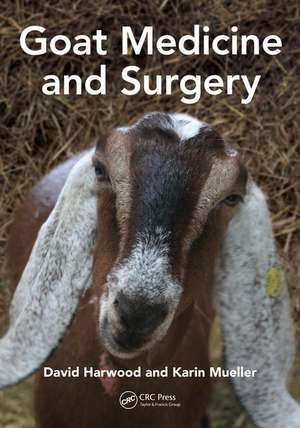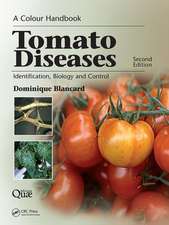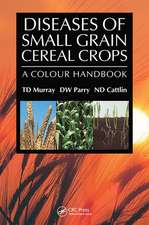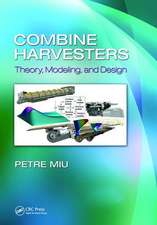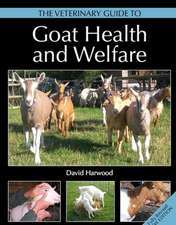Goat Medicine and Surgery
Autor David Harwood, Karin Muelleren Limba Engleză Hardback – 5 iul 2018
- Pam Brown, mixed practice vet at Alnorthumbria Vets, Wooler, in Veterinary Record, 27 April 2019
Key features:
Goats are one of the most widely kept domestic animals globally, mainly as a result of the relative ease with which they can be kept and the obvious benefits provided to those who keep them. Goat Medicine and Surgery describes the key diseases that can have an impact on goat health and welfare worldwide, providing information on diagnosis, treatment, prognosis, management and control.
- Covers basic anatomy, common breeds and husbandry.
- Divided into chapters covering each body system
- Offers the common differential diagnoses, followed by the specific diagnosis and recommended treatments
- Covers a wide range of disorders, including new and emerging diseases
Modern goat keeping gives us a full spectrum of activity from nomadic tribes moving with their animals, to the range-keeping in Australia, to units fattening goat kids for meat and to intensive goat dairy production systems. Alongside these production systems are those in which goats are kept in small numbers as a hobby, as pets and at public attractions. This book deals with the diseases and challenges impacting all kinds of goats and their owners. It will be invaluable to veterinarians in practice and training, animal scientists and agricultural advisors, as well as scientists interested in animal welfare.
| Toate formatele și edițiile | Preț | Express |
|---|---|---|
| Paperback (1) | 422.86 lei 22-36 zile | +37.72 lei 6-12 zile |
| CRC Press – 5 mar 2020 | 422.86 lei 22-36 zile | +37.72 lei 6-12 zile |
| Hardback (1) | 968.02 lei 43-57 zile | |
| CRC Press – 5 iul 2018 | 968.02 lei 43-57 zile |
Preț: 968.02 lei
Preț vechi: 1275.11 lei
-24% Nou
Puncte Express: 1452
Preț estimativ în valută:
185.26€ • 192.69$ • 152.94£
185.26€ • 192.69$ • 152.94£
Carte tipărită la comandă
Livrare economică 14-28 aprilie
Preluare comenzi: 021 569.72.76
Specificații
ISBN-13: 9781498748636
ISBN-10: 1498748635
Pagini: 392
Ilustrații: 350 Illustrations, color
Dimensiuni: 189 x 246 x 22 mm
Greutate: 2.5 kg
Ediția:1
Editura: CRC Press
Colecția CRC Press
ISBN-10: 1498748635
Pagini: 392
Ilustrații: 350 Illustrations, color
Dimensiuni: 189 x 246 x 22 mm
Greutate: 2.5 kg
Ediția:1
Editura: CRC Press
Colecția CRC Press
Public țintă
Professional Practice & DevelopmentCuprins
Chapter 1: Introduction: World goat population and reasons they are kept. Common Breeds. Goat Biology. Husbandry. Chapter 2: Reproductive System: Normal structure & function. Breeding management. Female reproductive tract diseases. Causes of foetal loss / abortion. Male reproductive tract diseases. Chapter 3: Pregnancy and Parturition: Pregnancy diagnosis. Normal kidding. Dystocia. Caesarean section. Pseudopregnancy / cloudburst. Chapter 4: Neonatology: Neonatal kid care. Neonatal disorders. Disbudding. Castrating. Supernumerary teats. Chapter 5: Alimentary Tract and Abdomen: Examination. Non-infectious disease. Infectious disease. Surgical conditions / procedures. Chapter 6: Respiratory System: Examination. Non-infectious disease. Infectious disease. Chapter 7: Cardiovascular Disease and Disorders of the Haematopoietic System: Examination. Cardiovascular disorders. Haematopoietic disorders including lymphatic system. Chapter 8: Nervous System Disorders: Examination. Non-infectious disease (CNS). Non-infectious disease (peripheral). Infectious disease. Chapter 9: Musculoskeletal Disease including Foot Disorders: Examination. Non-infectious disease (including fracture management). Infectious disease. Chapter 10: Urinary Tract Disease: Examination. Non-infectious disease. Infectious disease. Surgical procedures. Chapter 11: Skin Diseases: Examination. Non-infectious disease. Infectious disease. Surgical procedures and wound management. Dehorning / disbudding. Chapter 12: Mammary Gland: Examination. Non-infectious disease. Infectious disease. Surgical procedures. Chapter 13: Sensory Organ Disease: Diseases of the eye & surgical procedures. Diseases of the ear. Chapter 14: Metabolic Diseases. Chapter 15: Trace Element Disorders. Chapter 16: Poisoning. Chapter 17: Emerging and Exotic Diseases: Tuberculosis. Bluetongue. Schmallenberg. FMD. Chapter 18: Anaesthesia and Analgesia, Fluid Therapy and Euthanasia. Chapter 19: Post Mortem Examination and Sampling. Appendix 1: References Ranges: Appendix 2: Pharmacology. Index.
Notă biografică
David Harwood BVetMed, MRCVS: David qualified from the Royal Veterinary College in 1974, and worked in farm animal practice until 1983. He then joined the Ministry of Agriculture (now Defra) working for 30 years as a veterinary investigation officer, focusing on the investigation of farm animal disease and production problems by post mortem examination, laboratory testing and field investigation. He has a special interest in ruminant health and welfare, and farm animal disease surveillance. He was President of the British Cattle Veterinary Association in 2002 / 2003.He is currently working as an independent veterinary consultant, is an Honorary Veterinary surgeon to the British Goat Society and Chairman of the Goat Veterinary Society. He is an honorary reader in veterinary pathology at the University of Surrey, and a visiting lecturer at a number of UK Vet Schools on goat health and welfare.
Karin Mueller MVSc DCHP DECBHM MRCVS: Karin graduated in Germany and worked in private practice and academia in a variety of positions in the UK and New Zealand, including leading the farm animal clinical section at Cambridge veterinary school for over a decade. She completed a MVSc in Theriogenology, holds both the European and RCVS Diploma in cattle health, and is a European Specialist in bovine health management. In addition to her expertise in ruminant medicine, Karin has been involved with South American Camelids since 1999, greatly contributing to the advancement and further understanding of health and disease in these species. She was awarded the Felipe Benevides Trophy in recognition of her contributions to the camelid industry in 2012. Karin regularly speaks at national and international conferences and has authored numerous publications in the fields of bovine, caprine and camelid medicine. She is particularly interested in reproduction, medicine, and soft tissue surgery. Karin is now a Senior Lecturer in reproduction and animal husbandry at Liverpool University, and works as a consultant in camelid and bovine medicine.
Karin Mueller MVSc DCHP DECBHM MRCVS: Karin graduated in Germany and worked in private practice and academia in a variety of positions in the UK and New Zealand, including leading the farm animal clinical section at Cambridge veterinary school for over a decade. She completed a MVSc in Theriogenology, holds both the European and RCVS Diploma in cattle health, and is a European Specialist in bovine health management. In addition to her expertise in ruminant medicine, Karin has been involved with South American Camelids since 1999, greatly contributing to the advancement and further understanding of health and disease in these species. She was awarded the Felipe Benevides Trophy in recognition of her contributions to the camelid industry in 2012. Karin regularly speaks at national and international conferences and has authored numerous publications in the fields of bovine, caprine and camelid medicine. She is particularly interested in reproduction, medicine, and soft tissue surgery. Karin is now a Senior Lecturer in reproduction and animal husbandry at Liverpool University, and works as a consultant in camelid and bovine medicine.
Recenzii
As textbooks go, this is one of the few that I may actually choose to read in a spare moment, not just when madly researching what could possibly be the problem when I get called to a goat farm. It contains interesting information on the background of goat farming, goat behaviour, nutrition and husbandry in the introductory section. This is an area that was poorly covered during my time at vet school and, had I not had good exposure to goat medicine in practice, the temptation would always be to assume their needs are the same as those of sheep. Despite being written by two of the most well-known goat vets in the UK, the information is based at general practitioner level. The layout makes for easy reading with suitable text size, plenty of colour photos of live animals, postmortem findings, ultrasound scans, radiographs and histology samples... Those of us who treat goats know how few products are licensed for treating them, but this book gives detailed recommended dosages that won’t be found on any medicines packaging. This hardback, logically presented book will live on a handy shelf to be used on a regular basis.
- Pam Brown, mixed practice vet at Alnorthumbria Vets, Wooler, in Veterinary Record, 27 April 2019
- Pam Brown, mixed practice vet at Alnorthumbria Vets, Wooler, in Veterinary Record, 27 April 2019
Descriere
This book describes key diseases encountered in general practice along with their diagnoses, treatment, prognoses, and control. Diseases and disorders are included with the common differential diagnoses followed by the specific diagnosis and recommended treatment(s). In addition the book covers basic anatomy, commons breeds, and husbandry.
